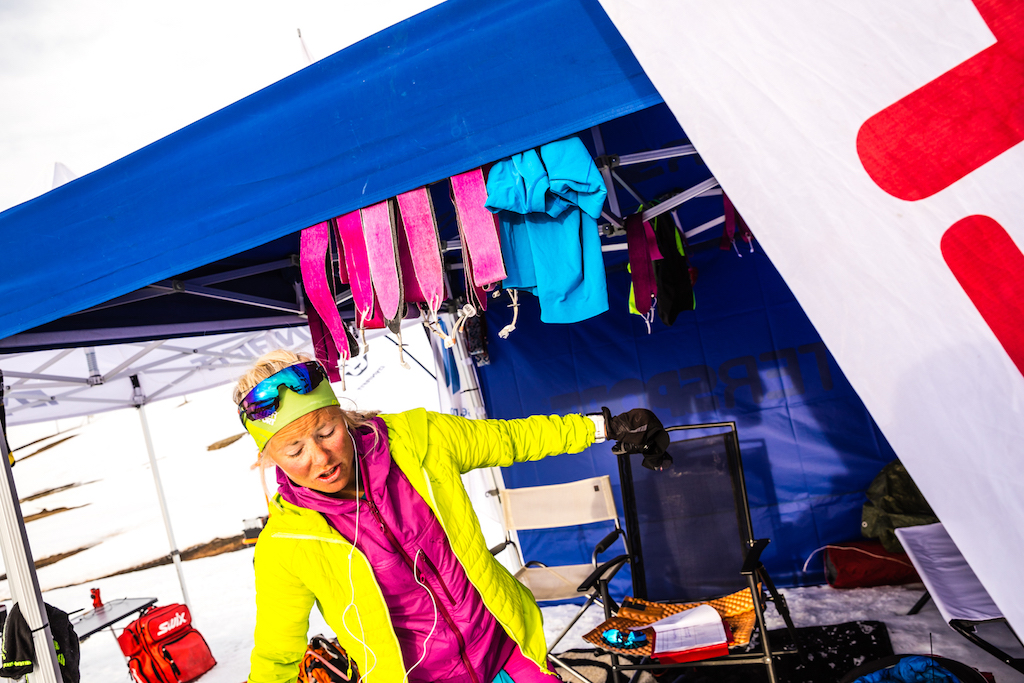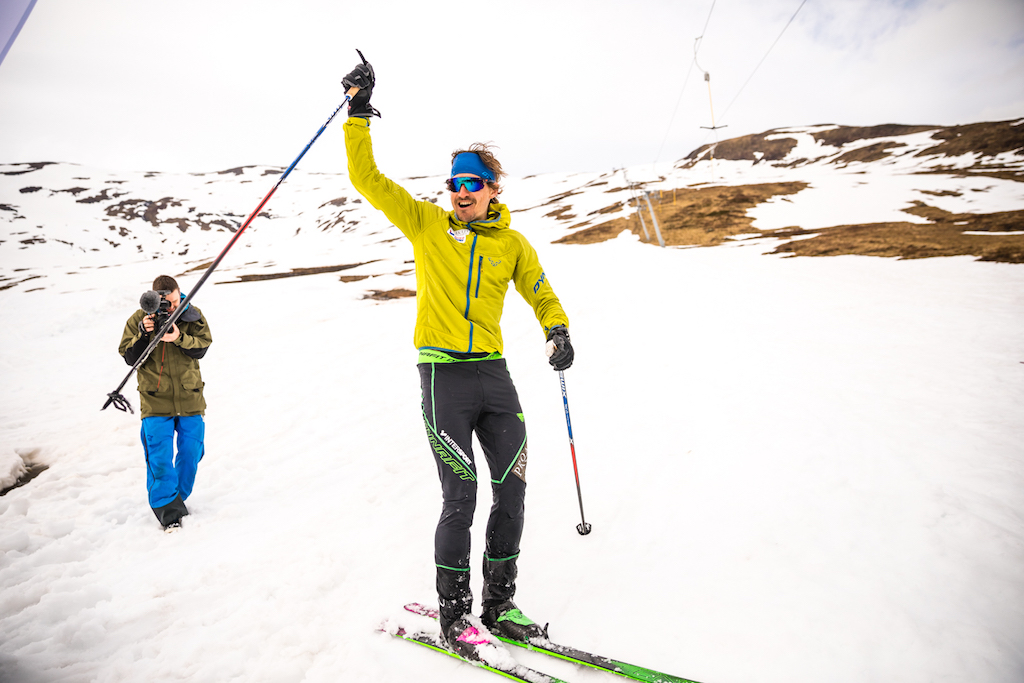On May 20, Malene Blikken Haukøy, a 26-year-old ultrarunner and member of the Norwegian National Ski Mountaineering Team, and Lars Erik Skjervheim, a 37-year-old Norwegian ultrarunner and ski-mountaineering racer, broke seemingly unheard-of world records.
At Myrkdalen, the largest ski area in western Norway, Haukøy skied 50,656 vertical feet, setting a new women’s record for the most vertical skied in 24 hours. That’s the equivalent of summiting Mount Rainier nearly six times in a day. Skjervheim skied 68,697 vertical feet (equal to over seven Rainiers), looping the same half-mile course and climbing about 1,500 vertical feet per lap 44 times in a day, setting a new men’s record.

“After 24 hours, I just wanted to sit down,” said Malene Blikken Haukøy. (Photo Credit: Haakon Funderud Lundkvist/Dynafit)
It’s an obscure goal, for sure, but it turns out, it’s more sought-after than it seems. In 2004, Austrian Günter Burgsteiner skied uphill 55,812 feet, then in 2009, an Austrian ski-mountaineering racer named Ekkehard Dörschlag set a new record at 60,350 feet. That year, 2009, American blogger and ski mountaineer Steve Romeo wrote on his site, TetonAT.com: “I think the record will be pushed even higher in the next few years. How much vertical can the most skilled and fastest rando racers climb on skis in a 24-hour period? My guess is that it’s close to 70,000 for the men and over 50,000 for the women.” Romeo tragically died in an avalanche in 2012, but his estimates were spot on—it would just take nine more years to get there.
In 2011, a French World Champion ski-mo racer named Florent Perrier attempted to beat the record but fell just short of the 60,000-foot mark. For the last seven years, the record has sat untouched. Until this year, when a 34-year-old ultrarunner from Missoula, Montana, named Mike Foote decided to give it a shot.
“I love doing events that last all day long, but ski-mo races, which I’ve been doing for a few years now, usually only last a couple of hours,” Foote said. “I started to wonder how I could push myself on skis in the same way I push myself in a 100-mile mountain race. I had to do some digging on the internet but I found that others had attempted 24-hour efforts in the past. I thought it would be a fun process to prepare for a record attempt, so I got to work.”
Foote trained for months, logging 10,000- to 15,000-foot days in the Montana backcountry, and in March 2018, he broke the record, climbing 61,200 vertical feet in a day on a course at Montana’s Whitefish ski area, with help from a support team. “The most challenging part was actually the first couple of hours of the attempt, which were particularly hard for me,” Foote said. “I had a lot of doubt and fear in the beginning of the effort and I had to just keep moving early on until I found my rhythm.”

Mike Foote celebrating his 24-hour record in Montana in March. (Photo Credit: Steven Gnam)
Two months later came Haukøy and Skjervheim from Norway. Skjervheim topped Foote’s record by 7,500 feet. “My first reaction was, ‘Dammit!’ and my second reaction was, ‘And he broke it by so much!’” Foote recalled.
Skjervheim said he had been thinking about the record for years, but when he heard of Foote’s success in March, it motivated him to go for it. He started logging long days, scouted a course and lined up friends to support him over the 24-hour mission. When he finished with a new world record, he said, “I almost felt a little bad breaking Mike’s record. I think he did a good job.”
Haukøy, who used the same support crew and course as Skjervheim, crushed the existing women’s record of 34,546 feet, which was set in 2009 by American writer Dina Mishev while competing at a 24-hour ski race at Colorado’s Sunlight Mountain Resort. “I have always been fascinated by extreme challenges and pushing my body to the limit and things that haven’t been done by many people before,” she said. “I feel mentally stronger than ever, and I got to know my body and mind so well. The days afterward, I felt kind of invincible. If I can do this, I can do anything.” Haukøy said she thinks other women will try to beat her record as soon as next year, but she has no plans to attempt this feat again.

“The sensation when I was finished was overwhelmingly positive,” said Lars Erik Skjervheim. (Photo Credit: Haakon Funderud Lundkvist/Dynafit)
So why is there suddenly so much interest in this quirky, outlying world record now? “Maybe it’s a coincidence? Or maybe it’s a sign of the sport growing?” Skjervheim said. Foote agreed. “Participation is growing and folks are more likely to explore what’s possible on the fringes of the sport. Perhaps it’s just a normal evolution,” he said.
After he finished the 24-hour ski course, Skjervheim said he never wants to do that again. It was too painful. But what if someone beats his record—then will he try again? “Of course, I don’t have to do it again, but as the saying goes, you should never say never,” Skjervheim said. “I don’t know what the future brings. If someone breaks it, I may get new motivation.”
As for Foote? “Will I attempt another 24-hour record? Phew. I’m not sure,” Foote said. “In the near future, I’m excited to get back to more exploratory training in the mountains and racing, but who knows what lies beyond that?”
